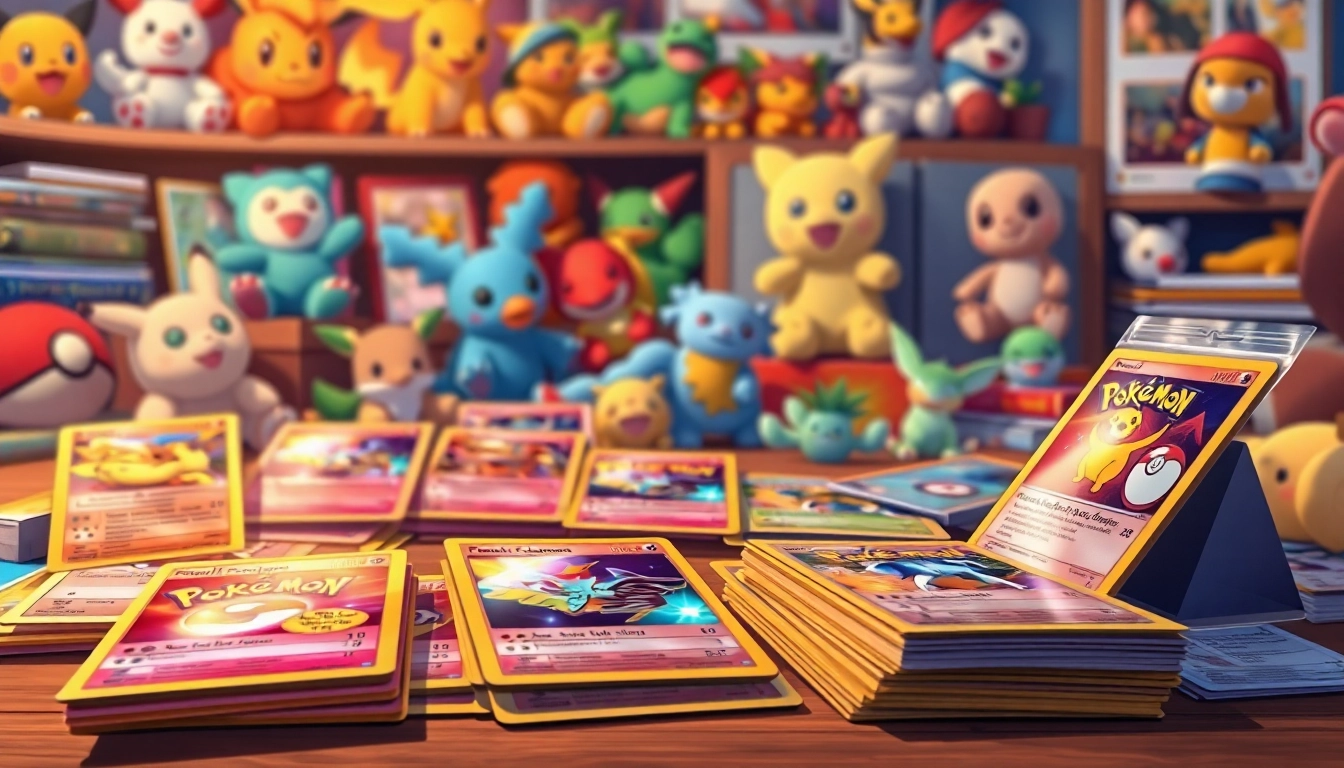Understanding Real Pokémon Cards
The world of Pokémon cards is vibrant and ever-evolving, captivating collectors and players alike. As the trading card game continues to grow in popularity, so does the need for enthusiasts to distinguish between authentic and counterfeit cards. Knowing how to identify real pokemon cards is crucial for building a valuable and trustworthy collection.
What Are Real Pokémon Cards?
Real Pokémon cards are officially licensed products created by The Pokémon Company, a subsidiary of Nintendo. These cards are part of a trading card game that has gained immense popularity since its inception in the early 1990s. Unlike fake or counterfeit cards, authentic Pokémon cards feature precise artwork, high-quality printing, and specific details that confirm their legitimacy.
Key Characteristics of Authentic Cards
Identifying genuine Pokémon cards can be easy if you know what to look for. Here are the key characteristics:
- Card Design: Genuine cards have clear and vibrant images, with no blurring, pixelation, or off-centering. The colors used in authentic cards are consistent and match the official prints.
- Card Material: Authentic Pokémon cards are made of a specific type of cardstock that feels different from the paper used in counterfeits. Real cards have a certain weight and texture that can be discerned by touch.
- Fonts and Text: The fonts used on real cards are precise, with specific fonts and sizes for the names, descriptions, and statistics. Be wary of any inconsistencies in text size or placement.
- Holographic Images: Many Pokémon cards feature holographic images that change appearance when tilted. Check for depth and clarity in the holographic sections as fakes often lack this feature.
- Ruler Test: Most genuine Pokémon cards are exactly 2.5 x 3.5 inches, which can easily be measured. Counterfeit cards can be slightly larger or smaller.
How to Spot Counterfeit Pokémon Cards
The market for Pokémon cards is unfortunately rife with counterfeits, especially as their value has rapidly increased. Here’s how to spot fakes:
- Light Test: Hold a card up to a light source; real Pokémon cards have a specific layer of light diffusion that allows some light to pass through, while fakes often appear too transparent or too opaque.
- Black Light Test: Under a black light, genuine Pokémon cards exhibit a specific shine. Counterfeits might not react in the same way.
- Detail Check: Look carefully for any blurred lines or inaccuracies in the art—most counterfeit cards will have fuzzy edges or odd colorations.
- Backside Comparison: The back of real Pokémon cards features a specific pattern that is difficult to replicate. Compare suspicious cards with known authentic cards to spot any discrepancies.
- Weight and Thickness: Often, fakes are either too light or too thick compared to genuine cards. Weighing them side by side can reveal discrepancies.
Where to Find Real Pokémon Cards
As a collector, knowing the best places to find real Pokémon cards is just as important as identifying them. The right resources can help you expand your collection while ensuring that what you purchase is genuine.
Online Retailers for Authentic Cards
Several reputable online platforms are known for selling real Pokémon cards:
- Pokémon Center: The official Pokémon website offers a secure and reliable place to purchase cards. It’s the top destination for new releases and exclusive items.
- TCGPlayer: This marketplace connects buyers to thousands of individual sellers. Information about card condition and authenticity is typically available.
- eBay: While eBay can be a mixed bag, many reputable sellers offer real Pokémon cards backed by authenticity guarantees. Always check seller ratings and reviews.
- Amazon: Amazon has a wide variety of sellers, and while it’s essential to confirm authenticity, it remains a popular choice for collectors seeking individual cards or bulk packs.
Local Game Stores and Collectibles Shops
Besides online options, many local game stores and collectibles shops regularly stock legitimate Pokémon cards. Here’s how to make the most of these locations:
- Joining Events: Many stores host Pokémon TCG events or tournaments. Attending these gatherings can give you access to exclusive cards and knowledge about local sellers.
- Building Connections: Get to know the employees and regulars at your local game store. They can offer valuable insights and tips on where to find real cards.
- Checking Inventory: Frequently visit your local shops to check their card selection. New inventory is often stocked regularly, and you might find hidden gems!
Top Marketplace Platforms for Buying Cards
In addition to specific online retailers and local stores, some market platforms specifically cater to trading card enthusiasts:
- Facebook Groups: Many collectors form communities on Facebook where they buy, sell, and trade cards. These groups can provide a more personal way to connect with fellow fans.
- Reddit: Subreddits like r/pkmntcg and r/PokemonCardCollectors offer marketplaces where users can trade or sell cards while engaging with the community.
- Instagram: Many collectors use Instagram to showcase their collections, while others run shops. Look for profiles that feature cards for sale and build trust through interaction.
Evaluating the Value of Real Pokémon Cards
For many collectors, knowing the value of their cards is a key aspect of their hobby. Understanding how to evaluate and price real Pokémon cards is essential for buying and selling.
Factors Influencing Card Prices
The value of Pokémon cards can fluctuate significantly based on various factors:
- Rarity: Cards designated as rare—like holographic versions or first editions—tend to have higher value due to their scarcity.
- Condition: The physical state of a card greatly influences its market value. Cards can be graded from 1 (Poor) to 10 (Gem Mint), and higher grades will typically command higher prices.
- Market Demand: Trends in the collector community can affect prices. Popular sets or characters may see a surge in value based on current interests.
- Recent Sales Data: Platforms like TCGPlayer regularly update their statistics to reflect recent market values; collectors should refer to these numbers when assessing their own collections.
How to Price Your Collection Accurately
To ensure you are pricing your collection appropriately, follow these steps:
- Research: Utilize TCGPlayer and eBay to research recent sales prices for identical or similar cards. This will provide a realistic expectation of your card’s value.
- Condition Review: Assess the condition of your cards accurately. Use the grading scale to evaluate your cards and compare them to others in the same condition to determine a fair market value.
- Seek Expert Opinion: Consider reaching out to local game stores or experienced collectors who can offer advice on pricing.
Investment Potential of Rare Pokémon Cards
Investing in real Pokémon cards can be a rewarding endeavor. With the right knowledge and strategy, collectors can see substantial returns on their investments:
- Solid Investment: Rare Pokémon cards, especially first editions and those graded highly, have appreciated significantly over the years. Many collectors view these as viable long-term investments.
- Market Trends: Stay updated with market trends and news influencing the Pokémon TCG community. Seasonal shifts and new game releases can impact the desirability of certain cards.
- Diverse Portfolio: Diversify your collection by investing in cards from various series, types, and eras. This strategy can mitigate the risks of market fluctuations.
Building Your Real Pokémon Card Collection
Starting and growing a collection of real Pokémon cards can be an exciting adventure. Here are strategies to build a well-rounded collection that stands the test of time.
Beginner Tips for New Collectors
If you’re new to collecting, these tips can help you kickstart your journey:
- Start Small: Instead of trying to collect every card, focus on specific sets or characters that you love. This targeted approach makes the collection process less overwhelming.
- Attend Events: Participate in local Pokémon events and tournaments. Not only will this increase your knowledge, but you can also trade cards with other collectors.
- Keep Learning: Read articles, watch videos, and engage with the Pokémon community to deepen your understanding of the hobby.
Organizing and Preserving Your Cards
Once you’ve acquired some cards, proper organization and preservation will protect your investment:
- Card Sleeves: Always store your cards in protective sleeves to prevent wear and tear. Consider using ultra-protective cases for your most valuable cards.
- Storage Options: Use binders with clear pockets for easy access to your collection or dedicated card boxes for safe long-term storage. Ensure any box used is free from moisture.
- Maintain Optimal Conditions: Store cards in a cool, dry place away from direct sunlight. Extreme humidity or heat can damage cards over time.
Choosing the Right Display Methods
Displaying your collection can be just as fulfilling as collecting. Consider these display methods:
- Frames and Shadow Boxes: Display favorite cards in frames or shadow boxes to highlight their value and artistry while keeping them safe from damage.
- Display Cases: Invest in acrylic display cases for particularly rare cards. These can be showcased on shelves while offering good protection.
- Online Showcases: Share your collection through social media or dedicated collector websites to connect with others and receive feedback and tips.
Engaging with the Pokémon Collecting Community
Being a part of the Pokémon card community can enhance your collecting experience tremendously. Here’s how to engage effectively:
Joining Local and Online Collectors Groups
Building relationships with fellow collectors can improve your knowledge and collecting skills:
- Local Meetups: Seek out local meetups for card trading, discussing strategies, and building friendships with others who share your passion.
- Online Forums and Groups: Platforms like Discord and Reddit have vibrant Pokémon card communities where you can ask questions, share your collection, and learn from experienced collectors.
Participating in Trading Card Events
Events are a fantastic way to experience the community firsthand:
- Tournaments: Participate in local, regional, or national tournaments. These events provide opportunities to compete and engage with other collectors.
- Conventions: Attend conventions dedicated to gaming and collecting, where you can buy, sell, and trade cards while meeting like-minded individuals.
Staying Updated with Pokémon News and Releases
Keeping yourself informed about the latest Pokémon happenings can offer immense advantages:
- Follow Official Channels: Subscribe to Pokémon’s official channels, newsletters, and social media. This keeps you updated on new releases, trends, and events.
- News Aggregator Sites: Utilize websites that aggregate Pokémon news, reviews, and collector insight articles, helping you stay at the forefront of the collecting universe.
- Engage with Influencers: Follow YouTube channels and blogs dedicated to Pokémon card collecting. Many collectors share insights, tips, and current market trends.



